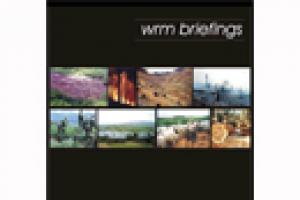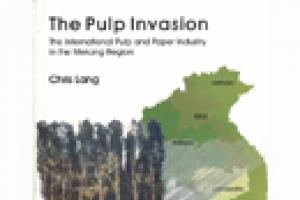Many years before there was scientific evidence of the destruction of the environment, the major artists and poets had noted the phenomenon in their essays, songs and poetry. In Puerto Rico, authors such as Enrique Laguerre, Abelardo Diaz Alfaro and Luis Llorens Torres denounced the destruction of our beautiful landscape and valuable natural resources, done in the name of "progress". The well-known poet, Juan Antonio Corretjer observed with great pain the overwhelming encroachment of concrete and the use of poisonous chemicals in Puerto Rican farming.
Large-Scale Tree Plantations
Industrial tree plantations are large-scale, intensively managed, even-aged monocultures, involving vast areas of fertile land under the control of plantation companies. Management of plantations involves the use of huge amounts of water as well as agrochemicals—which harm humans, and plants and animals in the plantations and surrounding areas.
Bulletin articles
2 January 2003
According to information available in FSC's web page, seven companies in Chile have certified "forests" covering a total area of 262,168 hectares. However, only one of these companies (Las Cruces S.A.) is actually managing a forest, covering an area of only 3,588 hectares. The rest (258,580 hectares) are monoculture tree plantations, which unfortunately continue to be considered as "forests" by FSC.
Bulletin articles
2 January 2003
In Ecuador, the Esmeraldas forests are part of the relict tropical forests on the Pacific coast of America. These forests are part of the Choco bio-geographical region, one of the planet's ten "hot spots", stretching from the South of Panama to the North of Esmeraldas. There are some 10,000 species of plants in this zone, of which some 2,500 are endemic. This is the home of the Awa, Chachi and Tsachila peoples and of Afro-Ecuadorian communities, which keep up traditional life styles.
Publications
17 December 2002
Forests are one of the most valuable eco-systems in the world, containing over 60 per cent of the world's biodiversity. This biodiversity has multiple social and economic values, apart from its intrinsic value, varying from the important ecological functions of forests in terms of soil and watershed protection to the economic value of the numerous products which can be extracted from the forest. For many indigenous and other forest-dependent peoples, forests are their livelihood.
Publications
9 December 2002
This report was produced in 2000-2001 for the World Rainforest Movement, looking at the current state of the pulp and paper industry in the Mekong Region: Thailand, Laos, Cambodia and Vietnam. The research covers the extent of plantations and their social and environmental impacts in the region, the role of the various institutions in supporting the expansion of industrial plantations, and the patterns of local resistance to ecological damage and loss of livelihood.
Bulletin articles
3 December 2002
Three important international forest-related events took place during 2002: the Sixth Conference of the Parties to the Convention on Biological Diversity; the World Summit on Sustainable Development; and the Eighth Conference of the Parties to the Convention on Climate Change. They were not much use. Beyond the rhetoric and the commitments agreed on at these and previous meetings, no positive impact can be noted.
Bulletin articles
3 December 2002
Burdened by a mounting foreign debt and pushed by globalisation and trade liberalisation, Ghana, as many other West African countries, has had its ability to finance domestic public spending severely constrained. In addition most of the exports of African countries suffer decline in prices leading to overall poor returns in revenue and contributing to huge budget deficits.
Bulletin articles
3 December 2002
The cuddly tree logo of the Forest Stewardship Council adorns the products of alien industrial tree plantations, as well as those of the real thing (forests, that is). It could mean virtually anything to the average person buying those products, but it is clear that the intention of the logo is to enhance the marketability of the timber products in question.
Bulletin articles
3 December 2002
Southeast Asian countries --particularly Indonesia and Malaysia--, have over 20 million hectares or 60 percent of the world's tropical peatlands. Peat swamps occur inland just beyond coastal mangroves and often spread over some 3km to 5km on the floodplain of rivers. They are characterised by an 8m to 20m thick layer of peat, which is mainly semi-decayed plant material accumulated over some 8,000 years. As long as the peaty soil is saturated with water, the swamp ecosystem is in balance.
Bulletin articles
3 December 2002
At the beginning of the nineties, the introduction and cultivation of eucalyptus, a species originating in Australia, was promoted as a major timber business. However, at the end of the decade, this model of large scale tree monoculture has finished by causing big economic losses to the State and to a large number of farmers.
Bulletin articles
3 December 2002
The PCF (Prototype Carbon Fund) is the World Bank's fund that mobilizes resources to promote the carbon dioxide trade, whereby contaminating companies --mainly located in the countries of the North-- can "negotiate" with forestry producers which supposedly trap carbon --mainly located in the countries of the South. And it is to the PCF that, representatives of dozens of bodies, citizen movements, churches, parliamentatians, city councillors and citizens of the Brazilian States of Minas Gerais, Espirito Santo, Bahia and Rio de Janeiro will be sending a letter.
Bulletin articles
3 December 2002
The more that is planted, the more rights that are lost. In Colombia, there are approximately 170,000 hectares of oil palm plantations. Testimonies by a delegate of the palm sector workers' organisation, connected to the Bucarelia and Las Brisas Palm Oil companies, denounce the poor working conditions in the oil palm plantations in the department of Santander, in addition to pressure and incentives to weaken the trade unions in the sector. Oleaginosas Bucarelia has 4,700 hectares and the other company some 2,800, all located at Puerto Wilches, Santander.


